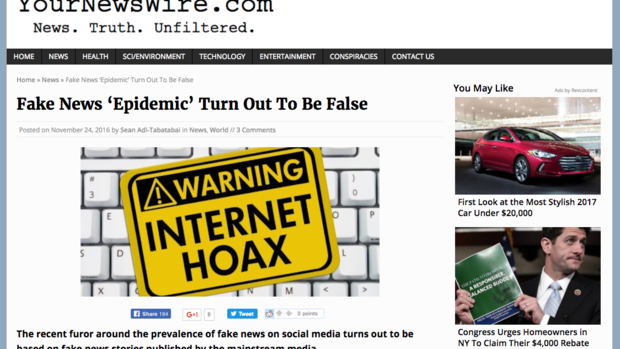Fake news? Not if it has "Trust Indicators"
Since the explosion of fake news that some say swayed the 2016 presidential election, social media companies have increasingly cracked down on fabricated news and robo-accounts in an effort to rebuild trust among users.
Now news organizations are joining the fray. Ten media companies -- including The Washington Post, The Economist, the Independent Journal Review, Mic and publishers in Canada, Italy and Germany -- are rolling out a project they hope will reverse Americans' historically low confidence in the news media.
Run by the Trust Project, a consortium of news organizations, the new system consists of so-called Trust Indicators, a set of tags giving audiences the signal that an organization abides by a certain set of standards. The eight indicators explain things like an organization's ethical code, its funding, journalists' backgrounds and how they get their stories.
The project lead, journalist Sally Lehrman, describes it as a nutrition label for news.
"You can see what's in your food: how much sugar, how much iron. You can look at it and say, today, it's fine for me. Or, no, it doesn't meet my needs," she said. "The public can make their own decisions based on these disclosures that are coming from the news industry itself."
Lehrman is the senior director of journalism ethics at Santa Clara University's Markkula Center for Applied Ethics, which is hosting the Trust Project. In the process of developing the indicators, she commissioned interviews with news consumers to figure out what kinds of aspects made newspapers more or less credible.
"There are categories of folks who really do want to be informed, but they're having a hard time being able to tell what's trustworthy or not," she said. "That's where we come in."
Initially, eight indicators can be independently applied to a story. They include categorizing the type of content (separating out opinion, analysis and sponsored content); indicating the presence of citations and references for in-depth stories; showing if a story is locally sourced; and showing whether a newsroom that produced a particular piece of journalism promotes diverse perspectives.
The 10 organizations using the indicators will all implement them this month, according to the Trust Project.
Many industry observers blame the advent of the internet, and social media in particular, with creating an environment that favors salacious or grabby information over content that's factually accurate but less exciting.
"Most Americans have some trust in information they're getting from profession organizations, but very few have a lot of trust," said Jeffrey Gottfried, a senior researcher at the Pew Research Center. "Where that shifts is information they're getting from social media."
People tend to trust information found on social media significantly less than information from other sources, Gottfried said. Compounding the problem, many readers -- about four in 10 -- are unable to identify the source of news stories that they click on through social media, according to Pew.
"That provides a challenge for news organizations," Gottfried said.
The Trust Indicators could help with that. In addition to a "Trust" logo that can go on a newspaper's website, the eight tags indicating a story's various aspects are machine-readable and able to appear on Facebook (FB), Twitter (TWTR) and Google (GOOG), and on other search engines. Those three tech companies, along with Microsoft's (MSFT) Bing, have all agreed to use the indicators in some way, the Trust Project said.
For now, it's unknown how exactly they'll be used. Craig Newmark, one of the Trust Project's founders, suggested that Google's search algorithm could rank trusted sources above others in search results. A social network could also display a logo next to shared content to show that it comes from a trustworthy source.
But for now, it's unclear how tech companies -- which control how most Americans today find information -- will use the indicators.
And this isn't the first attempt to combat misleading news. Facebook and Twitter have publicly committed to crack down on fake information, with mixed results, and there have been calls for increased government oversight of the tech giants. This is the first such effort to come from the news industry itself, however.
"What's exciting is that all of a sudden, a whole bunch of journalism organizations are working together to do a much better job of reporting," Newmark said.
Newmark has in recent years made a cause of funding journalism, committing this year to give away $6 million through his philanthropic organization. (Newmark, who founded Craigslist, has also been criticized for his role in the migration of classified advertising to the web, which eliminated a major funding source for small newspapers.)
Of course, whether these indicators will actually foster trust in the news is an open question. In terms of the people fake news reached and the money it made, the fabricated stuff was often more successful this year than the real kind. Still, it appears that the need for accurate and true information hasn't quite died out. For instance, organizations working on issues concerning media integrity have seen an influx of funding in recent years.
As Newmark said: "I just want news I can trust. I want to be able to open up a newspaper and not have to think about is this biased or false."




